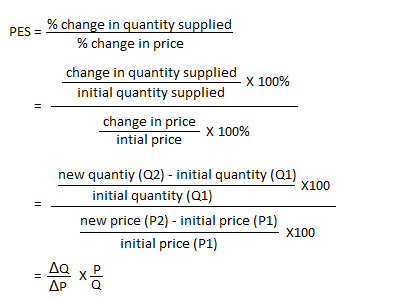What is price elasticity of supply?
In Economics, elasticity is defined as the degree of change in demand and supply of consumers and producers with respect to the change in income or price of the commodity.
Particularly, price elasticity of supply is a measure of the degree of change in the supplied amount of commodity in response to the change in the commodity’s price. In simple words, it can be defined as the rate of change in supply in response to a price change. It is denoted as PES or Es.
Mathematically, price elasticity of supply is expressed as

Degrees or Types of Price Elasticity of Supply
The degree of elasticity of supply can be of five types. They are described below in brief with figure.
Relatively elastic supply
When percentage change in quantity supplied is greater than percentage change in price, the condition is known as relatively elastic supply. This situation when plotted in graph makes an upward slope which intersects positive Y-axis.
Fig. i: relatively elastic supply curve

In figure i, we can see that ratio of change in quantity supplied is greater than the ratio of change in price. As a result, when we put their values in the above mathematical expression, we get PES>1.
Elasticity tends to be greater than 1 in case of products which are not necessary to sustain our lives. Luxury goods such as expensive smart phone, gold, etc. show this kind of price elasticity.
Relatively inelastic supply
When the percentage change in quantity supplied is lesser than percentage change in price, the condition is known as relatively inelastic supply. This situation when plotted in graph makes highly inclined upward slope which intersects positive X-axis.
Fig. ii: relatively inelastic supply curve

In the above figure, it is clearly shown that ratio of change in price is greater than ratio of change in quantity, whose value when substituted in the given expression, we get PES<1.
Such kind of price elasticity can be observed in goods which are necessary in our day to day lives. Clothes, foods, etc. are good examples of these kinds of goods.
Unitary elastic supply
When percentage change in quantity supplied is exactly equal to percentage change in price, the situation is known as unitary elastic supply. This situation is graph is represented by an upward slope which intersects the origin.
Fig. iii: unitary elastic supply

In the above figure, the ratio of change in quantity supplied is equal to the ratio of change in price. Consequently, when the value of these variables are substituted in the given expression, we get PES=1. This behavior between price and quantity supplied of commodity is also known as lock-step movement.
Infinite/perfectly elastic supply
When a slight or minimal change in price causes infinite change in quantity supplied, it is said to be infinite or perfectly elastic supply. In a graph, such situation is represented by a straight line which is parallel to X-axis.
Fig. iv: perfectly elastic supply curve

In the above figure, we can see that quantity supplied has varied significantly even at the same price level. This kind of price elasticity is expected to occur in highly luxurious goods. However, perfectness of anything, including perfectly inelastic supply is considered to be rare or impractical in economy.
Zero /perfectly inelastic supply
When quantity supplied remains unchanged with change in price, it is said to be zero or perfectly inelastic supply. Such situation in graph is represented by a straight line which is parallel to Y-axis.
Fig. v: perfectly inelastic supply

In figure v, we can see that the amount of commodity supplied has remained unchanged even when the price has greatly changed. This type of price elasticity is expected to be observed in highly essential goods such as medicines. However, as mentioned earlier, perfectness of anything in economy is rare or impractical.
